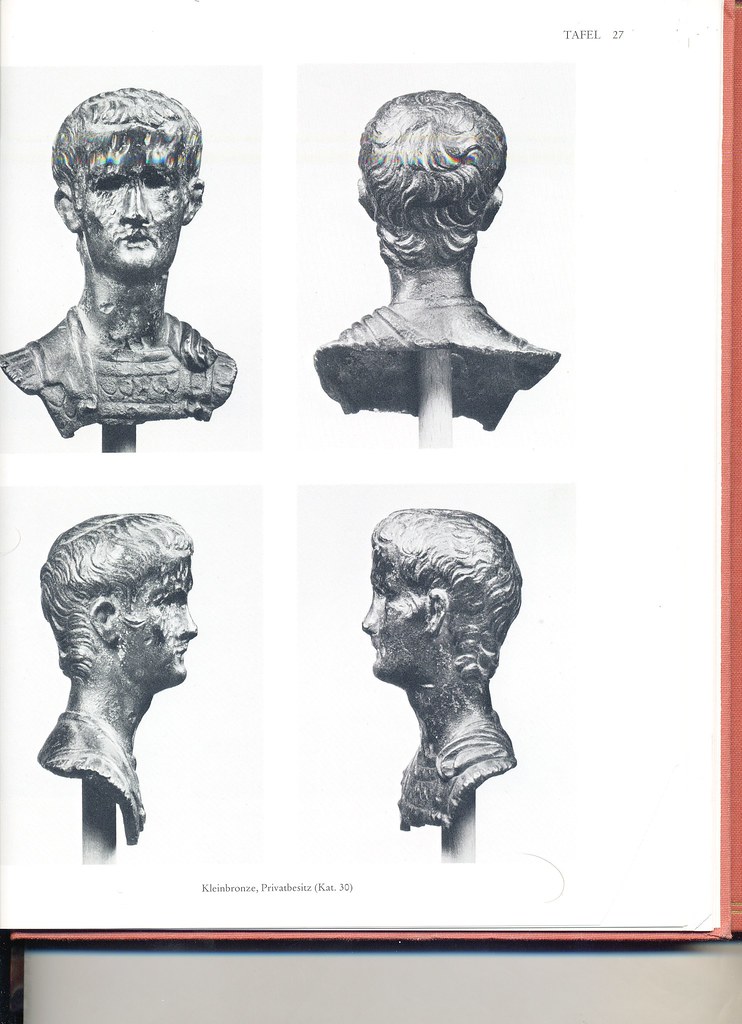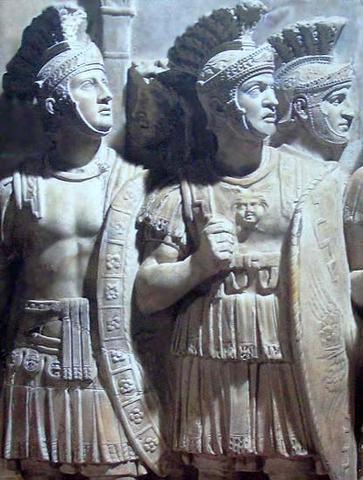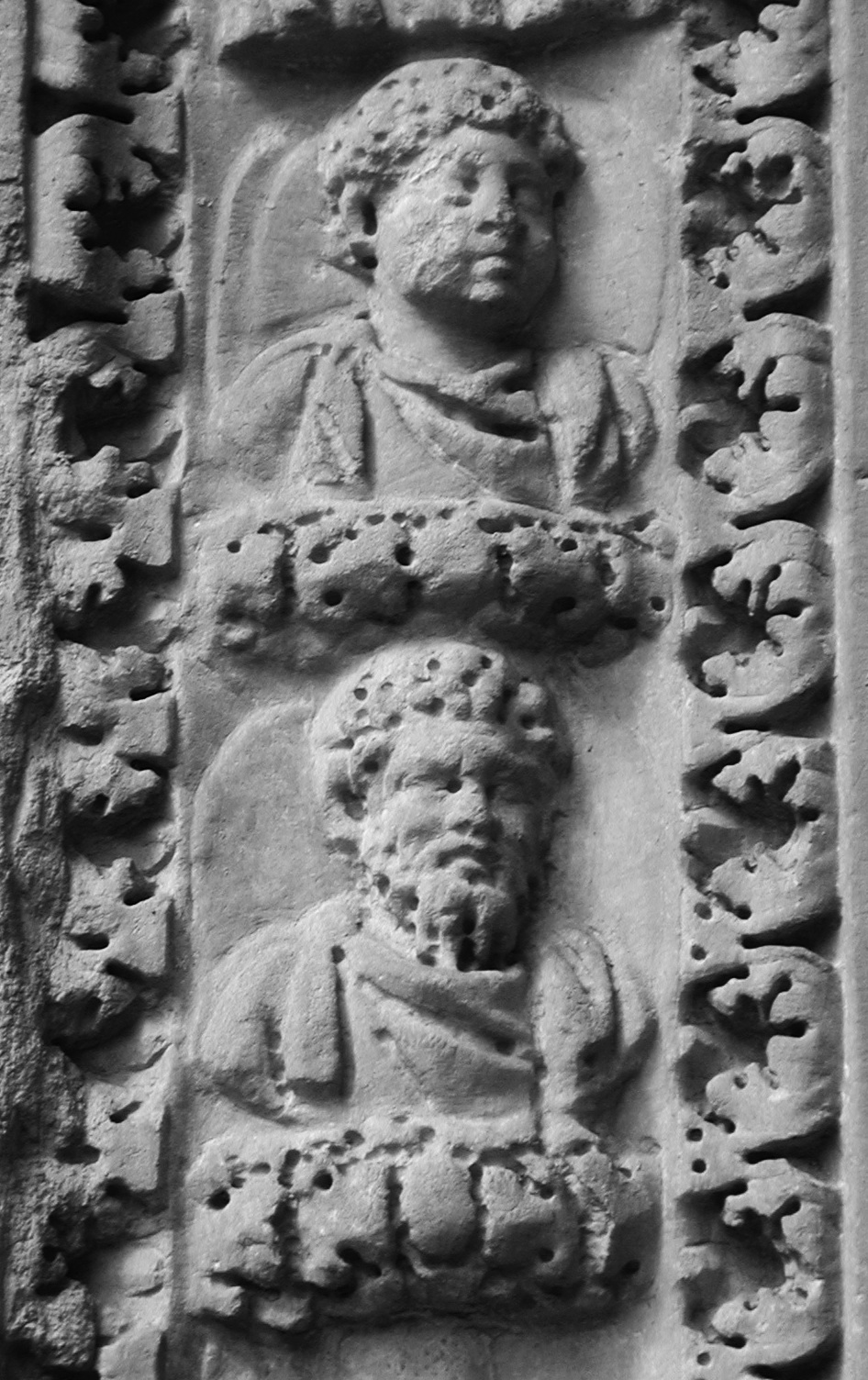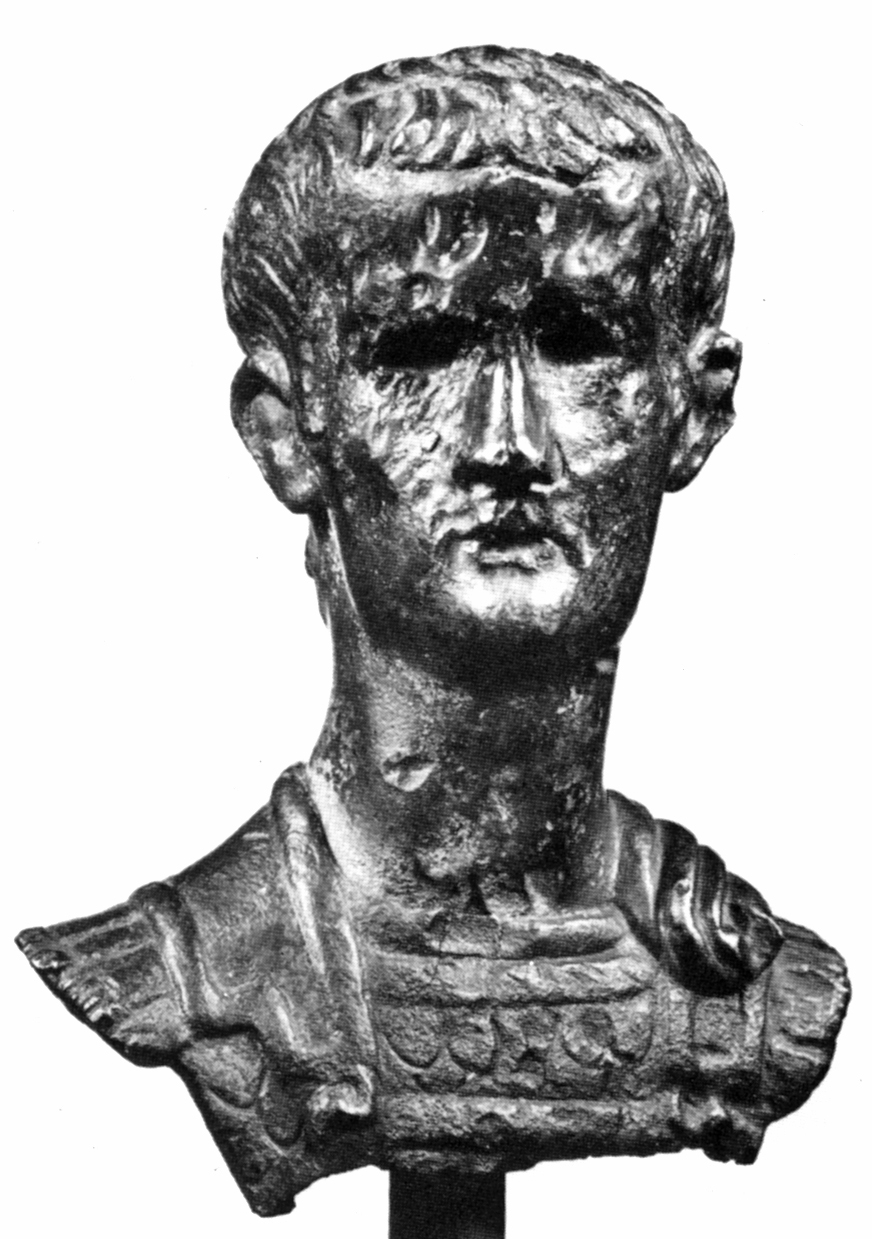A Small Bronze Mutilated Head of Gaius Caligula
By Joe Geranio
UPDATE 6/1/2014 ON POSSIBLE MILITARY
ATTRIBUTION? From my friend Prof. John Pollini - REF TO RICCARDI
http://www.digitalsculpture.org/papers/pollini/pollini_paper.html
An actual small bronze
bust of
Caligula with battered facial features, which had been thrown into the
Tiber (fig. 3), may have once served as a bust-decoration for an actual military
standard, perhaps even (given its
provenance) of the Praetorian Guard in
Rome, or it may have been used as a finial-ornament affixed to the top of a pole.
For this small bronze
bust in a Swiss private collection (height: 9.7 cm), which H. Jucker had proposed might have once been
part of a Roman
standard, see Boschung (1989) 91, 115 (cat. 30) pl. 27.1-4. As H.R. Goette suggested (see previous note), the
type of
cuirass (
lorica plumata or squamata) worn by
Caligula in this
bust may have some reference to the Praetorian Guard. For representations of small metal busts of emperors decorating Roman standards and as finials atop poles, see Riccardi (2002) especially 94-99 and fig. 23.1.
One thing I noticed between the Caligulan bronze sculpted portrait and the Louvre relief is the wide straps on military uniform? Example- forefront guard has right hand on strap. Between the
sestertius and the bronze sculpted portrait of Caligula- the epaulet
area is wide on the soldiers on
reverse of
sestertius and the bronze sculpted portrait? (more to come)
This relief now in the Louvre gives a
good representation for the Praetorian guard from the late Claudian to early Neronian period.
Praetorian relief circa 51-52 A.D., marble 161 x 123 cm. The Louvre in
Paris, (MA 210MR.337) Cat. no. 115. Found in
Rome , documented in 1577, and
part of the Mattei collection since 1615, it was acquired in 1824.
Part of the arch of Princeps
Claudius, ruled from 41-54 A.D. Parts of this wonderful
Julio Claudian sculpture were
restored in the 16th century. (partly from art text.)
Why the lack of S.C.? This was clearly a way for Caligula to give a special donative to the Praetorian Guard. It was supposed to show the Praetorians loyalty and Caligula 's loyalty . Remember, coins were like a billboard in early empire of Rome. Especially with a young princeps like Caligula. He was popular early on because his father was the beloved Germanicus, but this went away quickly.
It seems ironic that this portrait has possible praetorian iconography attached to the cuirass and was a possible obliteration by the same guards he tried to have in his rhetoric/ propaganda to show unity? The praetorians actually murdered Caligula! Lets look at one more wonderful piece of propaganda:
The Donative Adlocvtio C CAESAR sestertius. This reverse gives great insight on what the die engraver was going for on Caligula 's features on adlocvtio obverse (a torvitas) and youthful physiognomy and for the reverse: Military rhetoric/propaganda? The military iconography also is important for dating of shields , helmets and standards, as well as sella chair which Caligula stood and sat upon while addressing troops. Tradart, JDL #48
ADLOCUT[IO] COH[ORTIUM], a highly original type that shows the new emperor addressing a group of five soldiers (RIC 32f). This type presumably refers to the donative Caligula gave to the Praetorians on his ascension. The sestertius may have been struck as a commemorative and distributed among the soldiers. He was the first emperor to acknowledge a debt to the guards.
Below is a small bronze mutilated cuirassed portrait of Gaius Caligula that was clearly mutilated as a result of an angry praetorian soldier or citizen in the years 37-41 A.D. This portrait is in private hands and unfortunately I had to scan it from my book and this photo is for educational use only. The photo of the larger portrait below was given to me by Prof. John Pollini. There of course was no official "damnatio memoriae" of Caligula but none the less many portraits especially the smaller ones were intentionally mutilated or defaced, its a shame I could not have examined this portrait at a museum or a gallery. obviously D. Boschung ( die bildnisse des Caligula, 1989) was able to obtain these rare photos and therefore the scan is shown in the best quality I could muster up. The main damage is done directly to the face and is quite aggressive, you can see the deep screwdriver type nicks in the front facial area. Although we guess as whether the damnatio was done intentionally to an emperor or princeps , there is no doubt this was deliberate and without much love for the princeps. This portrait was found in the Tiber river in Rome. It gives us a rare glimpse into how the population was feeling about Caligula in the early empire. The thing I find most fascinating is in the short reign of Caligula (37-41) either coins that have been defaced or portraits such as these show us exactly in a small span of history what a huge role numismatics and portrait study has made a difference in verification of Roman history. His uncle and successor, Claudius, had his statues and portraits removed from public view. Many were reworked as portraits of Augustus or of Claudius. It also seems that smaller, personal images of Caligula were deliberately thrown away after his murder; several have been recovered from the River Tiber in Rome. According to Jucker the bust , "may have served once as a bust decoration for an actual military standard, perhaps even (given its provenance- found in Tiber river) or as a finial ornament affixed to the top of a pole. So the imperial image before which soldiers usually swore their oath-- at least initially to a new princeps--probably took the form of a small bronze imago clipeata ("shield portrait") or some small sort of small bust applique like that attached to the military standard (signum) carried in battle, or it may even have been a small bust affixed to the top of plain pole as finial. Such standards and poles were also used in parades and kept in the shrine (saecellum or aedes) of a military camp along with portrait statues of the princeps (and his designated successor), images of the gods, and other military insignia. Thus, represented on the Severan Arch of the Argentarii in Rome is a Praetorian standard with attached small busts of Septimius Severus (below) and his young son and designated successor Caracalla. SEE: 2 photos below for example of what Pollini is speaking to regarding military standards and portraiture.

Praetorian
standard from the Arch of the Argentarii,
Rome: Courtesy H.R. Goette after Pollini
Photo below courtesy Prof. John Pollini.
Bibliography:
H. Jucker - D. Willers (Ed.), Faces. Greek and Roman portraits of Swiss ownership, Ausstellungskat. Bern (1983) Cat. no 117.
D. Boschung, The portraits of Caligula. The Roman ruler image I 4 (Berlin 1989) 115 Cat. no 30 seats 27, 1-4. 45, 1 Geranio, Portraits of Caligula: The Seated Figure? (Society of Ancient Numismatics) Vol. XX no. 1 1997. Digital Sculpture Project: Caligula- The Image of Caligula: Myth and Reality, 2014 Symposium at VMFA.
1. Digital Sculpture Project: Caligula
The Image of Caligula: Myth and Reality
John Pollini
Dahmen, K. 2001. Untersuchungen zu Form und Funktion kleinformatiger Portršts der rŲmischen Kaiserzeit. Munster: Scriptorium, p. 159, no. 44, pl. 44.
Varner, Eric R. ed. 2000. From Caligula To Constantine : Tyranny & Transformation in Roman Portraiture. Atlanta : Michael C. Carlos Museum, p. 102-3, no. 8.












